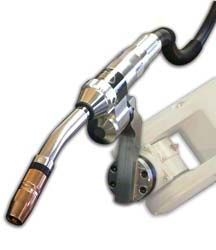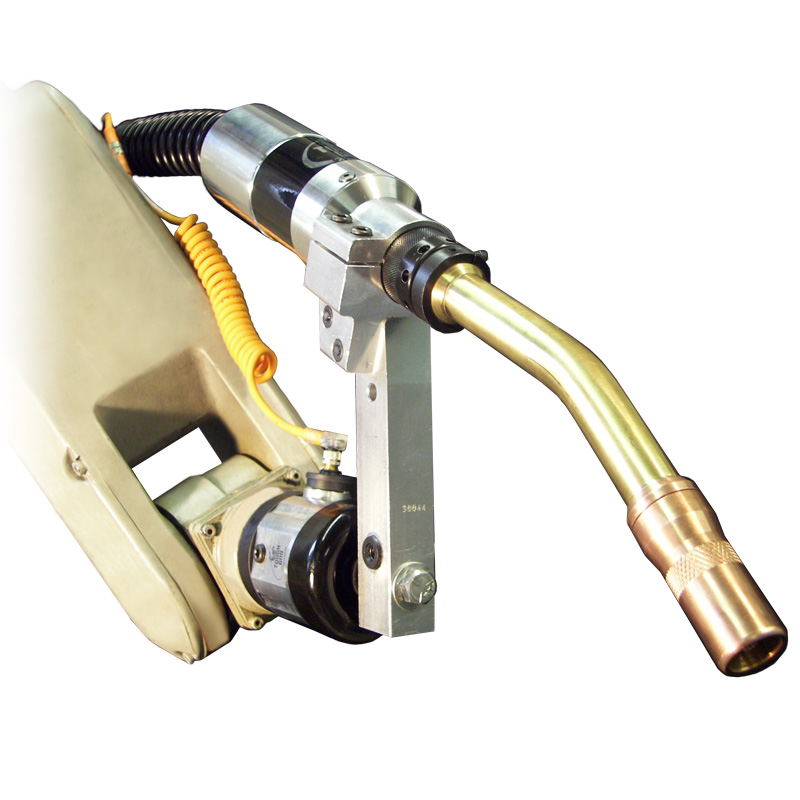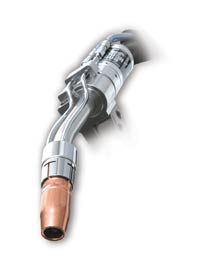Choosing the Right Robotic Gun for MIG Welding Applications

including an air-cooled model (as shown
here), can help ensure good weld quality,
and reduce equipment and maintenance cost — factors that lead to a good return on investment and greater productivity.
From high-volume, low-variety manufacturing facilities to low-volume, high-variety fabrication shops, robotic welding has become increasingly popular due to the potential weld quality and productivity improvements it can provide. Not only do those benefits make it an attractive investment for growth and profitability, but they can also provide companies with a competitive edge.
Selecting the right equipment for a robotic welding operation, however, is not a task to be taken lightly. From determining the correct style of robot to suit an application’sparticular requirements to deciding which welding peripherals to purchase, companies must always choose wisely. Selecting the appropriate robotic MIG gun that suits the requirements of the application is also essential for optimizing the return on investment. For example, using a robotic MIG gun that has a higher amperage capacity than required can unnecessarily increase the total cost of ownership. Conversely, selecting an inadequate MIG gun can lead to performance issues, costly downtime and premature failures.
Instead, companies are encouraged to select a robotic MIG gun that is suitable for the amperage, duty cycle and cooling capacity needed for the application. Doing so helps ensure good weld quality, and reduces equipment and maintenance costs. The right robotic MIG gun also helps companies improve productivity.
The following information helps to outline key considerations towards making the right selection.
Staying Cool with Air-Cooled Technology
Typically, air-cooled robotic MIG guns (rated at 500 amps) operate comfortably in the range of 200 to 300 amps at approximately 60 percent duty cycle with mixed gases (i.e. welding continuously for 6 of 10 available minutes). Further, these guns are ideal for welding thinner materials — typically upwards of 4 mm thick — and work best for shorter welds on high volume applications, including (but not limited to) those in the automotive or recreation equipment industry.
Air-cooled robotic MIG guns, like their semi-automatic counterparts, rely on the ambient air to cool them during the welding process. These guns feature a unicable through which the welding wire, gas and power are all delivered. Air-cooled unicables use the appropriate amount of copper to create a conductor that is capable of managing welding current without any additional cooling. When compared to water-cooled unicables of similar rating, air-cooled unicables generally have up to four times the circular-mils (i.e. cross section) of copper.
There are several advantages to using air-cooled robotic MIG guns, the most significant of which is their durability. An air-cooled neck has a much stronger and durable construction when compared to the neck on a water-cooled robotic MIG gun, making it more resistant to bending in the event of a collision or through general wear. Replacement parts for air-cooled robotic MIG guns also cost less and are easier to maintain. These guns tend to have a more streamlined design and smaller working envelope, allowing greater access into smaller joint configurations than a water-cooled robotic MIG gun. Too, air-cooled robotic MIG guns maintain their accuracy very well, which makes them an excellent option for applications requiring consistent, repeatable welds.
One limitation to air-cooled robotic MIG guns is the lower duty cycle when compared to water-cooled guns; they are not capable of welding continuously for as long as a water-cooled robotic MIG gun.
Just Add Water

offer high-amperage capacity for applications
requiring prolonged periods of welding.
Water-cooled robotic MIG guns offer excellent advantages for applications that require welding at higher amperages for prolonged periods of time. These guns provide high amperage capacity — generally 300 to 600-plus amps — and are capable of managing a duty cycle within the 60 to 100 percent range. They are designed for welding on thicker materials (typically 1/4 inch and greater), making them a good choice for applications in heavy equipment manufacturing or similar such industries. As a rule the larger the overall size of the weldment, the greater the chances the application will require a water-cooled MIG gun.
To prevent overheating, water-cooled robotic MIG guns rely on a supply of water or coolant from an external source. These sources include circulators or chillers, which tend to add to the overall cost and maintenance requirements of the system. The coolant travels through a water hose in the gun’s cable bundle (also containing the power cable, wire, and gas and water return hoses) and circulates up through the neck to the consumables. For very high-amperage applications, there are also water-cooled nozzles that are capable of circulating the coolant around the nozzle, but these are more expensive than standard ones.
As mentioned previously, water-cooled power cables (found in the cable bundle) have approximately 1/4 of the copper found in an air-cooled unicable; thus, water-cooled unicables quickly fail if the water supply is interrupted. This factor is a disadvantage of water-cooled robotic MIG guns, as the parts can be expensive and time consuming to replace should they become damaged.
Routine maintenance of the cables within the cable bundle can also be difficult, since they are all in close proximity to one another. And because these guns have internal water chambers in the neck, that part is inherently weaker than the neck on an air-cooled robotic MIG gun and much more likely to bend in the event of a collision. Still, for high-amperage applications that require high capacity cooling to protect the gun during long periods of welding, dealing with these disadvantages still make having a water-cooled robotic MIG gun worthwhile.
An Option in Between

offer the durability of an air-cooled
model gun with the greater cooling
capacity of a water-cooled one,
making them an ideal fit for welding
multiple thicknesses of materials.
For companies that weld multiple thicknesses of base materials and require both high and low amperage capabilities from a robotic MIG gun, a hybrid air-cooled/water-cooled robotic MIG gun is a good option. These MIG guns have a durable neck like an air-cooled model, but offer the higher cooling capacity of a water-cooled MIG gun. They feature exterior water lines that run along the outside of the neck to the nozzle, as opposed to through the neck like water-cooled MIG guns have. Hybrid air-cooled/water-cooled robotic MIG guns typically offer 300 to 550 amperage welding capacity at 60 percent duty cycle (using mixed gases).
Hybrid air-cooled/water-cooled robotic MIG guns also have features that provide easier maintenance compared to a true water-cooled product. For example, the water lines run independently of the power cable and are more accessible than with a standard water-cooled MIG gun, so these guns do not need to be taken off of the robot for maintenance. Plus, if there are issues with water circulation, these guns can rely on the underlying air-cooled unicable to provide enough current-carrying capacity to avoid a catastrophic failure such as destroying a power cable or other components. Overall, the features of the hybrid air-cooled / water-cooled MIG gun help provide a lower total cost of ownership for the gun.
One limitation of these MIG guns, like a standard air-cooled model, is the limit to duty cycle. For applications that require continuous duty cycles, these MIG guns would not be the best choice and a water-cooled product may have to be deployed.
Protecting the Assets
Regardless of which robotic MIG gun is right for a given application, good preventive maintenance is critical to ensuring product longevity and reducing unscheduled downtime. In particular, most robotic MIG gun manufacturers recommend using a nozzle cleaning station to prevent spatter build-up that can lead to quality issues or downtime (and costs) related to consumable changeover. Checking for loose connections along the length of the robotic MIG gun — from the power pin to the nozzle — is also key to preventing quality issues or damage that could cause the gun to fail prematurely.
Remember, choosing the appropriate robotic MIG gun to suit the requirements of the application is essential for optimizing the return on investment. Using the right robotic MIG gun also provides for a more reliable system and can help manage the total cost of ownership, particularly by minimizing performance issues, costly repairs, unscheduled downtime and premature failures. In the end, it takes less time and money to protect a robotic MIG gun with preventive maintenance procedures than it does to take the gun offline for repair or to replace it.


